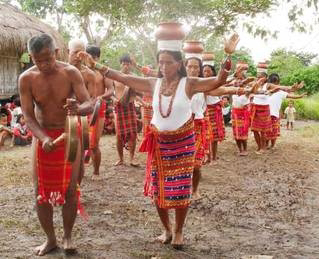Cultures and Traditions of Igorot
Some of the Cultures and Traditions of Igorot
Here are some cultures and traditions of Igorot that is being forgotten by the generation right now. The generation we have today focuses on the technology like gadgets and forgotten where we came from.
1. Kalon
• It is a type of arrangement, if a young man wants to marry a young woman, he would go to the village of elders (usually, the grandparents who have raised their own families and have a good standing and are being respected in the community) who in turn will tell the young man and his parents on what they need to prepared; usually, a chicken and a liter of tapey( homemade rice wine). Also they schedule a day on which they would accompany the young man to the house of the parents of the young woman. When the day comes, the elders, his parents will go to the house of the young woman with the chicken anf a liter of tapey. In the past, physical appearance doesn't matter instead the qualification if he can feed his family. The respectability of a single woman is tp stay pure until a man proposes a marriage to her. Another function of kalon is to ensure that no one is marrying his/her blood relatives.
2. Pudong
• The kalanguya version of engagement. It is intentionally shortened for fear that the woman might change her mind. The man and his family will prepare a pig not younger than 8 months and butcher it on pudong ceremony. Relatives of both sides as well as the elders of the village will be especiall invited. The family of the woman will prepare baskets full of kamote(sweet potato) or sacks of rice to be boiled and eaten during this affair. The mother or grandmother will also prepare pots of rice wine so that the elders and the man have something to drink.
3. Mumbaki
• It is traditional ritual for the Igorot people which is being apply for healing and good harvest. They believe that when a person is sick and can't healed by medicines they do the baki ritual which they connect with the soul of a dead person . They butcher a pig or a chicken with a tapey then after that the blood of the pig or chicken will be prayed by them which is called "mad-mad" in Igorot.
4 Ba-liw
• It is the poem version of Igorot. They do this ritual when there is a person who is already dead and wants to be transferred or wants to clean up his/her burial. They do this for the peace of mind in both of the family and the dead person because he/she will never stop bothering you if you can't fulfill what he/she wants.
5. Igorot Attire
•The ladies attire is called "tapis". They wear this for ritual, wedding day and in dancing the traditional dance of Igorot. They have also what they called "kayabang" which they use to put kamote.
• While the attire of the gentlemen is called "kubal". They wear this without underwear. They also have the bag which is made by the skin of a goat.
6.Tayaw and Hadung
• This is the traditional movement of a woman and a man in dancing the traditional dance of Igorot. The movement of the man is called "tayaw" while the woman called "hadung".
7. Watwat
• This is the trafitional way of Igorot when there is a wedding, celebration of success, thanksgiving and in burial. They butcher pigs and chop it equally and cook while the internal parts of the pigs will get and make it "punag". Punag is the intestines of the pigs that wash in the river and after they put the blood with garlic and onion. After cooking they chop it again equally. Punag is not good to eat for the children.
8. Tapey (rice wine)
• Is the famous alcoholic beverage of the Igorots.Traditionally, it is used or offered by the Igorots for libation during public feasts, thanksgivings or other activities. It is also served when someone host meeting or gathering at his house or at other place like the Dap-ay.
I think that's would be all. Thank you for reading and hope you learned something.🖤❣️








